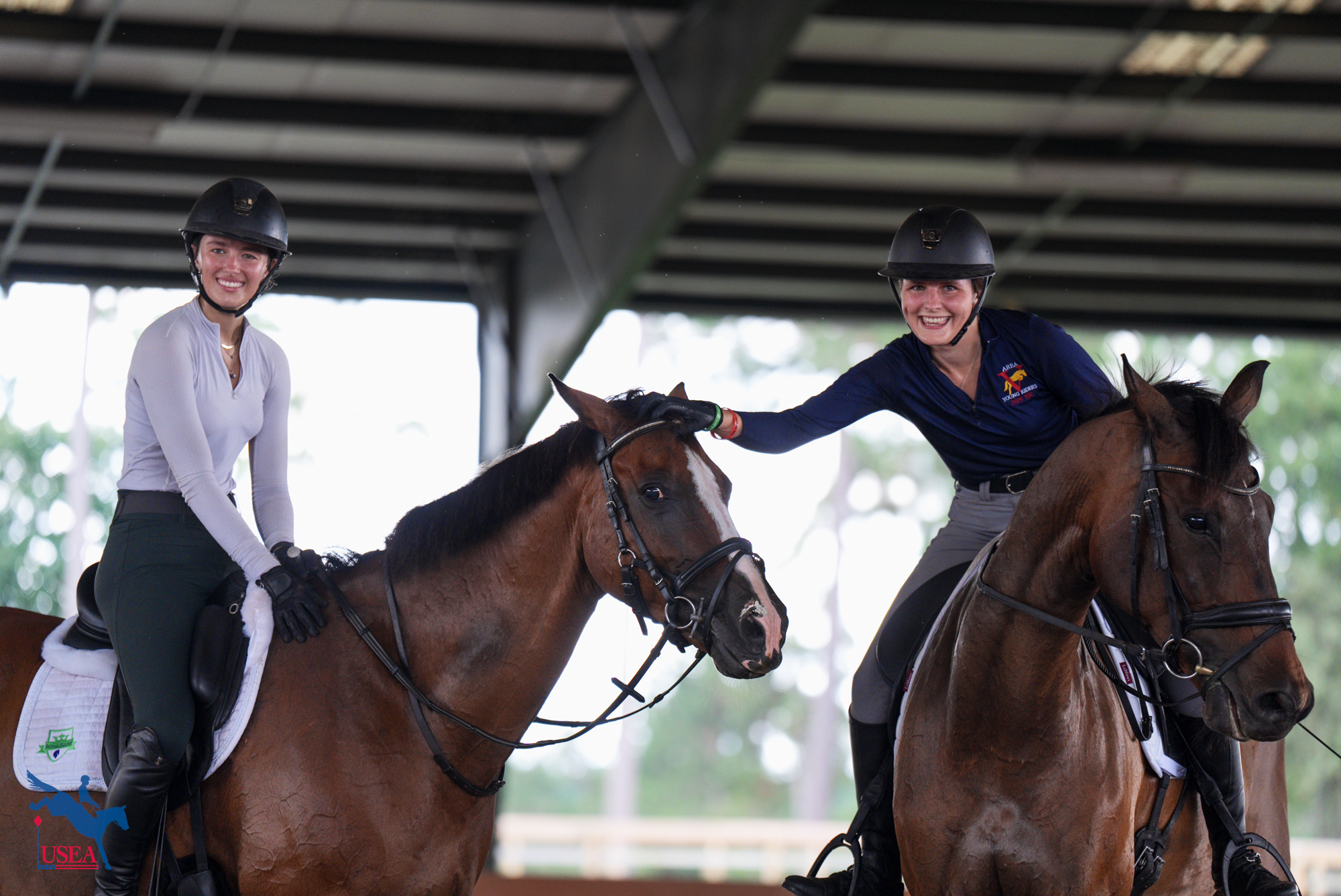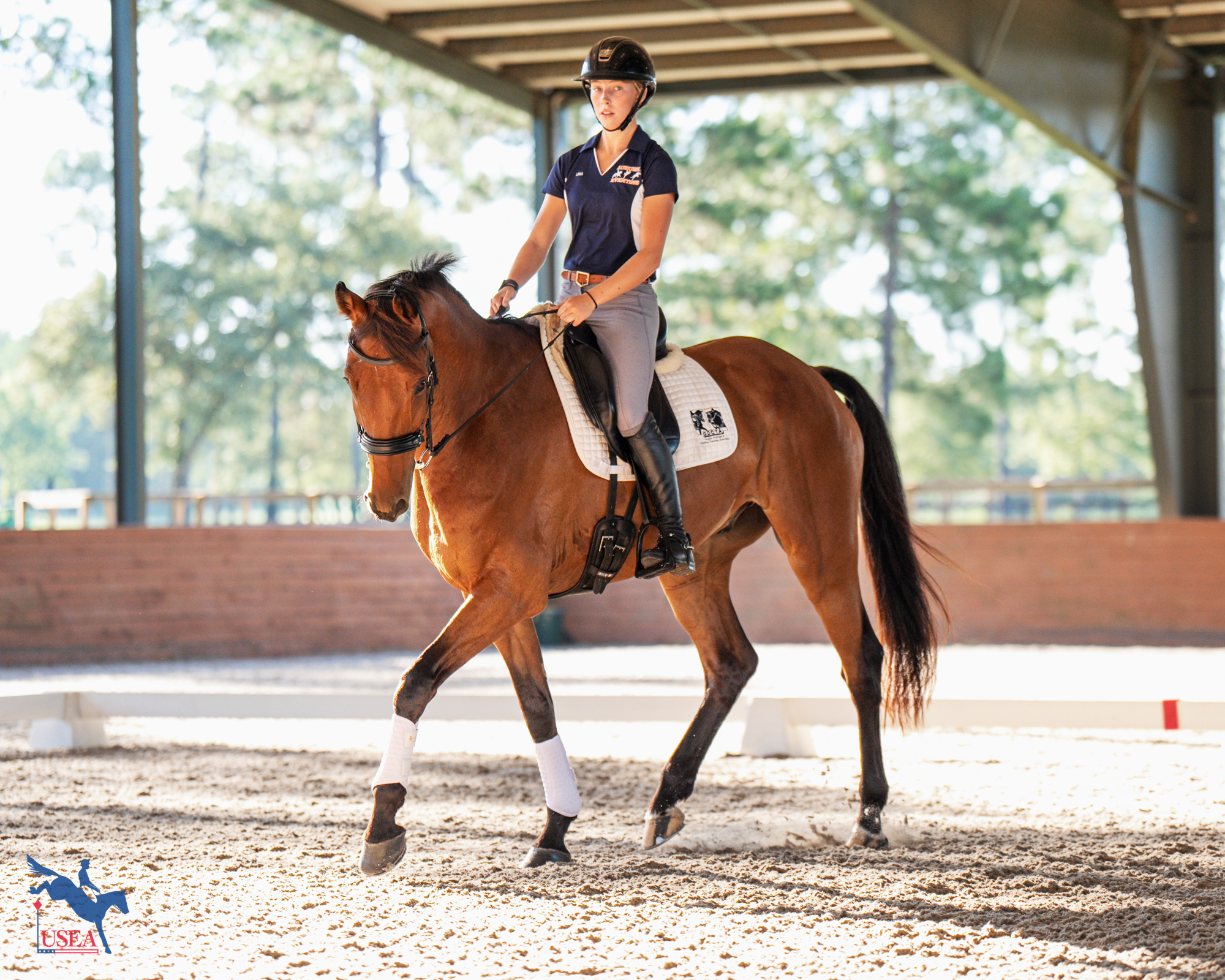Pick Your Lane: Day 1 of the USEA EA21 East Coast II Clinic

Aiken, S.C.—July 23— "Pick your lane and stick with it; it's all building blocks in the training scale." This was coach Emily Mastervich Beshear's central message for each of the morning dressage sessions during day 1 of the USEA Emerging Athlete U21 (EA21) East Coast II Regional Clinic held at Stable View.
Each of the 12 athletes attending the clinic came with a general understanding of the hallowed German Training Scale (rhythm, relaxation, connection, impulsion, straightness, and collection). And indeed, most students of the sport have surely heard it referenced by many clinicians, training vlogs, how-to articles, and the like. Beshear wanted all attendees, both in the saddle and on the sidelines, to keep the training scale at the forefront of their thoughts as they went through their lessons.
Ridden in pairs, the dressage sessions began with each rider running through a brief warm up where Beshear instructed them to "show off your horse's strong suits. Show me where they're the most comfortable." She likened her request to what you should strive for at a competition: "What can you do right now with what you have?" Beshear asked the watching participants to quietly observe each horse and rider, and then after the brief warm up period, offer up their own bullet point observations.
Interestingly enough, within each pair, the horses had dramatically different ways of going. This was apparent from the first session of the day where Breeana Robinette's "Ollie" and Tate Northrup's "Bourbon," while both quality Thoroughbreds, were polar opposites in their forms and apparent weaknesses on the training scale. While Ollie was very steady and consistent in the bridle, he lacked the impulsion Beshear was looking for to elevate his performance. Bourbon, on the other hand, had plenty of reach through his shoulder but needed to seek out the contact and slow down his tempo.

Beshear ran through a quick exercise with the pair before having them switch horses. The reaction from the "peanut gallery" was immediate "oohs," and "ahhs," as both Ollie and Bourbon showed instant improvements under their new riders. Northrup was easily able to spark up Ollie's impulsion while maintaining his lovely, consistent frame, and Robinette had almost immediate success in stretching Bourbon down into the contact and getting him to open his stride and use his whole body. Beshear was extremely pleased and commented to the whole group how well each rider's strengths complimented their new mounts.
This was the point when Beshear shared her primary training principal for the day, "My biggest challenge has always been not to try and change too many things at once,” she said. “It's easy to see improvement and want to immediately get to the next thing, but the repetition is what makes those steps forward stick."
This result continued to repeat itself throughout the day. Some riders swapped back to their own horses to finish out their hour of instruction, while other pairs elected to stay on their new horse and either go through more training scale-focused exercises or run through a dressage test. In all cases though, Beshear continued to check back in with each rider on their original goal for the day and use new exercises as building blocks to achieve that goal.
While Beshear mixed and matched a myriad of different training exercises from session to session, they all consistently related back to the training scale and worked to achieve each horse and rider's individual goal. In fact, within each session, both pairs completed the same exercise as their session partner, but slight modifications and specific instructions from Beshear made each exercise productive and fruitful for even the most vastly different horses.
For example, in the fifth session of the day, Kelsey Seidel and Devon Tresan each rode a bay gelding, but that's pretty much where the similarities ended. Seidel's Chico’s ManVDF Z, a 14-year-old 15.3-hand Zangersheide, has competed through the five-star level. Tresan's Zavallo, a 10-year-old 17.3-hand Dutch Warmblood, will be doing his first two-star this fall. Beshear tasked them with the following exercise: canter through the short side of the dressage arena in haunches-in, change to shoulder-fore through the corner, while maintaining the shoulder-fore transition to the trot down the long side, and then carry the shoulder-fore back into the canter at the next corner. Lather, rinse, repeat. Each rider did this same exercise on their own horse and their session partner's.

For Zavallo, who "has a tendency to be short in the neck during the shoulder-fore but finds the haunches-in naturally easy," the exercise helped Tresan carry that forward momentum from the canter into the trot work and free up that shoulder-fore movement. Seidel stated that "going from Devon's massive horse, where the exercise seemed to happen so fast, back to Sprout and be able to slow everything down just because he's that much smaller, to me that was really eye-opening, and I wish I would have been able to do it one more time on her horse, and I would ride it so differently!"
Beshear was incredibly pleased with all the riders' adaptability to their new horses. "My plan for the day was to get these guys really going from just thinking as the rider on their own horse to becoming a little more thoughtful of the actual training process," she said. "The first aspect we talked about was making sure every time they get on a horse, whether it's their own horse or another horse, they're really assessing what they're feeling and how the horse is responding to them."
After a morning full of dressage and very successful rides, the clinic participants sat down for lunch and a dressage debrief. Beshear summed up the morning's lessons well. "Just keep accessing. Say to yourself, 'Alright what am I sitting on today?' Especially when you ride the same horse all the time. It's easy to get into a routine of thinking this is what you need to focus on instead of coming out and really feeling what's going on and realizing that oh your horse is starting to change."
She concluded, "Go back to the underlying training scale and know what your priorities are so when you get on, you're starting with a good foundation."
The jumping session will begin tomorrow morning at 6:30 a.m. EST to beat that southern heat!
The Participants:
- Kate Bell
- Grace Dilger
- Catherine Frank
- Audrey Littlefield
- Jillian Newman
- Tate Northrup
- Lara Roberts
- Breeana Robinette
- Rebecca Roth
- Kelsey Seidel
- Devon Tresan
- Jake Tessler
Don't forget to follow the USEA’s coverage on social media!
Facebook | Instagram | Twitter
About the USEA Emerging Athlete U21 Program (EA21)
The purpose of the USEA Emerging Athletes U21 Program (EA21) is to identify and provide consistent quality instruction to the next generation of elite event riders. The aim is to create a pipeline for potential team riders by identifying and developing young talent, improving horsemanship and riding skills, and training and improving skills and consistency.
The USEA Emerging Athletes U21 Program was launched in 2022 with a model of five summertime regional clinics taught by selected USEA Eventing Coaches Program (ECP) instructors, leading to a winter national camp consisting of selected Young Riders from the regional clinics. Athletes who are 21 years or younger, are current members of their USEA Young Rider Area program, and are established at the Training Level or higher, are eligible to apply for the EA21 program. Click here to learn more about the USEA EA21 Program.
The USEA would like to thank ARMA, Kerrits, PulseVet, Ride iQ, Sidelines Magazine, Schneiders Saddlery and #WeRideTogetherfor sponsoring the USEA Emerging Athletes U21 Program.






























